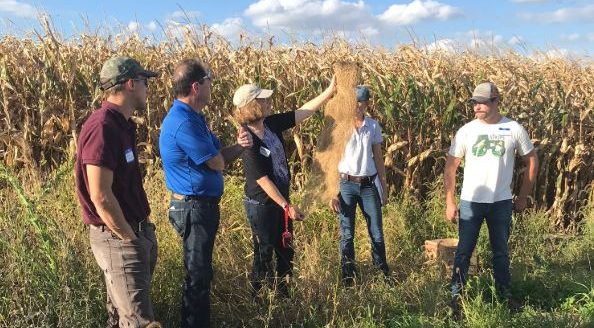Ismail Dweikat cupped his hand inside the brown paper bag he kept safely in a cabinet in his University of Nebraska office and pulled out the coveted seed.
It wasn’t easy, after all, to get his hands on industrial hemp seed, he said. It cost him nearly $1,000 in shipping alone to get it from Canada to Nebraska. Yet, someday in the future, maybe even in the next five years, he sees the seed becoming more readily available—giving farmers across the Midwest an alternative cash crop to plant in their fields.
“Once a week I’m getting a call about hemp,” Dweikat said, pointing to the blinking light on his phone. “Or, at least, an email. All the farmers want to see if they can grow hemp.”
But expanding industrial hemp acres in Nebraska has had hurdles, said Dweikat, who is a plant breeder and the leader research for the university’s hemp project. Nebraska lawmakers passed legislation to allow for university research four years ago, but in the second year of the program at the university site near Mead, Dweikat will grow just a few acres.
Paperwork and government regulation haven’t helped growth. For instance, in April, he planned a research project on a reservation to study the viability of hemp to the state’s corn and soybeans. Yet getting the Drug Enforcement Administration’s approval didn’t happen timely.
He added that to plant the crop at Mead, it took nearly two years to get the DEA permit and about six months to import seed from Canada.
Dweikat stays optimistic but stresses more research is needed. That includes a hemp breeding program that would develop varieties adequate to the Midwest climate.
Canada has longer day length, which means the hemp plant has more time to flower.
In Nebraska, with the shorter days, the hemp plant flowers much earlier than the native ditch weed and then stops growing. Thus, the plants are stunted and produce fewer seeds.
It’s why Dweikat heads to the backroads each fall, gathering wild hemp seed, to use someday when the gets the greenlight to start a breeding program that develops hemp with the characteristics farmers need in America. Besides a tall crop for seed, oil and fiber production, cultivated hemp also must be below the 0.3 percent THC threshold. With law enforcement already skittish about the crop, calling it a gateway for illegal marijuana production, Dweikat said he wants to make it easier for deputies to decipher between hemp and its close relative.
“My goal is to actually change the shape of the leaves,” he said. “The hemp leaves are fingerlike, so it looks like marijuana. I’d like to select for rounder leaves.”
Other questions also need answered before farmers start investing in a new crop.
‘I’m sure the farmer wants to know how much nitrogen to put on, how many plants they need an acre, what is the average cost per acre, profit per acre compared to corn and soybeans,” he said. “The farmer wants to know how much money I’m going to put in my bucket at the end of the day compared to corn. If it isn’t worth it, I don’t have to grow it.”
At the Mead site, he planted about 200,000 seeds per acre. He will compare the inputs to other crops, plus how the field yields in both dryland irrigation settings.
Hemp seeds can be harvested about 16 weeks after planting with a combine, he said. It’s then cleaned to remove stalks, leaves and immature seeds.
For fiber, harvesting of the stalks begins before seeds set and after pollination is complete.
“Tractor-drawn harvester spreaders can be used to cut hemp stems and lay them in windrows for field retting,” he said.
According to Cornell University, retting uses bacterial action or water to soften and separate the fibers. In Canada, farmers use baling and swathing equipment. But for some university researchers like Dweikat, after retting, the hemp is gathered and the stems tied into bundles.
Dweikat said he would like to do more. Another obstacle, however, is funding.
Dweikat said a change in federal law, such as the passage of a bill introduced by Sen. Mitch McConnell, R-KY, would exclude hemp as a controlled substance and provide federal funds for research.
“Instead of having one or two doing research, you will have 50 states doing research on hemp. With so many scientists doing research, you will have faster results.”
But for Dweikat, who has spent more than a decade researching sweet sorghum, hemp is a new challenge.
“I’m learning as I go,” he said. “I think in five years, the crops in the United States will be different. And hemp might be a major crop.”
Amy Bickel can be reached at 620-860-9433 or [email protected].



